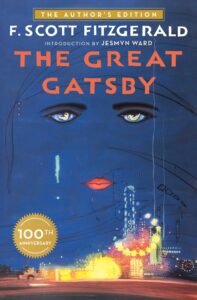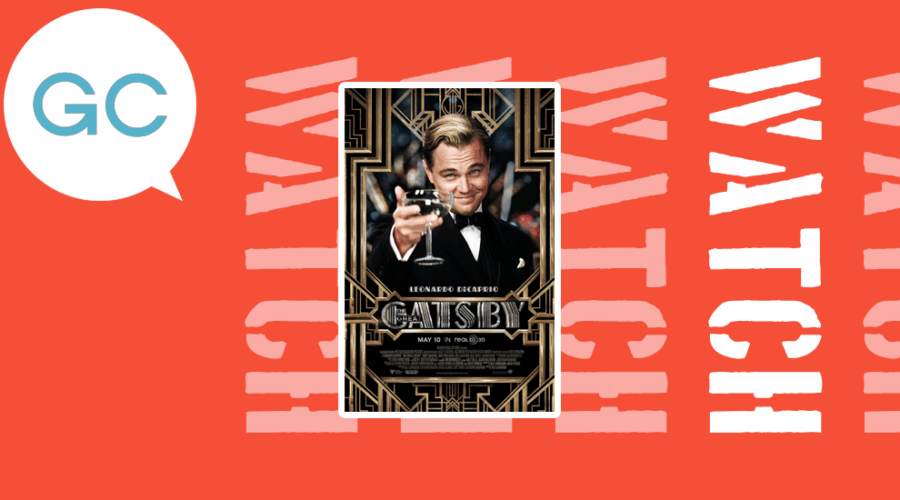Gatsby is set in the Jazz Age, the dark flip side of the American dream that lurks beneath the music, parties and fashion.
Baz Luhrmann famously adapted the novel in 2013, and like all his work, it’s visually spectacular while also telling a deeply human story. But what’s it actually about?
The story
 In the summer of 1922, Nick Carraway, a young bond salesman, moves to West Egg, Long Island, and finds himself living next door to mysterious millionaire Jay Gatsby.
In the summer of 1922, Nick Carraway, a young bond salesman, moves to West Egg, Long Island, and finds himself living next door to mysterious millionaire Jay Gatsby.
Gatsby is a vague and enigmatic figure: he’s renowned for his huge parties, always hosted at his mansion, but he appears not to attend them. As Nick gets to know Gatsby, he discovers that Gatsby’s whole life has been built around trying to win back his former love Daisy Buchanan, a distant relative of Nick’s who lives directly across the bay with her wealthy but unpleasant husband Tom.
Before long, Gatsby’s dream comes crashing down to earth, with an accident and a murder bringing the book to a head.
The novel, like many great works of literature, works on several different levels: on the one hand it’s a personal tragedy, but it’s also a sweeping critique of American society in the 1920s. Carraway’s role as both participant in and observer of the story allows Fitzgerald to immerse the reader in the glamour of the wealthy Jazz Age elite but also keep some emotional distance from the disasters that happen later in the book. Gatsby is enigmatic, which allows Fitzgerald to have him personify a sense of longing in a way that’s very moving for the reader – he has a big dream, and even though we can see how impractical it is, he’s moved heaven and earth to try and make it happen.
One of the joys of reading the book is that as a reader it requires you to pick up hints and cues about the characters’ motivations and the broader themes it explores, something that rewards multiple readings, as do the recurring symbols throughout the book which allow your understanding as a reader to deepen as the novel progresses.
The prose is beautiful without extravagance; Fitzgerald never gets carried away with description even though his writing is so thoughtful and evocative. This helps to keep the book on the shorter side: it comes in at under 200 pages and that’s largely because he’s so brilliant at writing beautifully but economically.
One of the key themes of the book is the sense of longing to return to the past, or an idealised version of it, especially when there’s something there we wish we could fix, or a different turn we could have taken.
The book is a testament to that type of specific and impossible yearning that we’ve all felt at one point or another.
Fitzgerald wasn’t afraid of moral ambiguity: the characters are all flawed and human and even the more obviously difficult characters aren’t completely villainous: their selfishness and weakness is something each of us can recognise.
The film: a visual feast
Baz Luhrmann’s 2013 film adaptation makes some significant changes to the story, including a framing device which places Carraway in a sanitarium, from where he recounts his story to a therapist. This allows for voice-over narration but changes Nick’s perspective, making him less ambiguous and more clearly damaged.
In the book, it’s clear that Nick is both simultaneously attracted to and repulsed by Gatsby’s world, which gives the book psychological depth, and some of that is necessarily sacrificed in the film.
As you’d expect from Luhrmann, the visual style is fun and flamboyant, with various historical anachronisms including the inclusion of contemporary music and the expansion of the party scenes into vast set pieces.
It works brilliantly visually, although the constant spectacle shifts the focus away from the psychology of the characters somewhat, unlike the book. However, as a symbol of hedonism and excess, it works perfectly.
The film is brilliantly cast: Leonardo DiCaprio brings a desperate, manic energy to Gatsby while Joel Edgerton as Buchanan is quietly menacing. While DiCaprio turns in a brilliant performance, we lose some of the enigma of the book’s Gatsby, who works as both an idea and as a person; when reading the book we’re forced to construct him from various fragments and rumours before we actually meet him. On screen, he becomes more concrete and while that’s both necessary and inevitable, I can’t help but feel we lose something in the translation.
Carey Mulligan, Elizabeth Debicki and Isla Fisher all bring a different sort of energy to their respective roles. Mulligan brings a softness to Daisy that is more fleshed out than in the novel, where she is more of a passive object of desire more than a woman with agency of her own.
The cinematography is as beautiful as you’d expect from Luhrmann and provides an immediate and striking contrast between the wealthy world of Gatsby and the Buchanans and the desolation of the valley of ashes, the industrial area that abuts the wealthier enclaves on Long Island.
This isn’t the only aspect of the book that the visual medium of film is able to highlight so effectively: the sensory overwhelm of the parties and their hedonist extravagance, as well as the physical beauty of the characters and the opulence of the fashion and jewellery all shine on the screen in a way which is less obvious in writing.
The emptiness that lies under the facade is emphasised by the sheer volume of visual spectacle in the film.
I do admire how the film makes the story feel contemporary without losing the meaning at its core. The combination of a modern soundtrack with such a contemporary visual style reminds viewers that the themes of wealth inequality, social mobility and moral corruption are just as relevant today as they were in the 1920s.
Where the visual medium of film works less well, for me, is when some of the book’s symbols become a bit too literal, the green light of the dock being the most obvious example. For me the symbolic aspects of the novel have more power when they’re quieter.
Book or film?
As far as pairings go, the novel and the film each play to the strengths of their respective mediums in a way that’s complementary. The novel is psychologically complex, morally ambiguous and has a symbolic depth which rewards close reading – even multiple readings – while the film is more emotionally accessible as well as beautifully filmed.
The film was criticised in some quarters upon release for not being serious enough, or for being spectacle more than substance. I think the key is to view the film as its own entity, and to look at whether it achieves what it’s trying to: the same standard we apply to literature.
I believe it’s successful in what it sets out to do – it brings the book to life and allows us to see the physical world of the story’s characters while delivering the story in a way that has plenty of emotional resonance as well as entertainment value.
It’s worth reading the book first in this instance – it’s fun to see the book brought to life in an interpretation which is so visually focused, but it’s a fuller experience after reading the book, rather than the other way around.
Ultimately, both the book and the film explore the same themes of reality versus dreams, hope and optimism, time and regrets and the American dream. One hundred years after the book was released, it’s extraordinary that it, and the film adaptation, still have so much to say that’s relevant to our current moment and experience.

